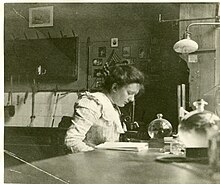Margarete Zuelzer
Margarete Hedwig Zuelzer (born February 7, 1877 in Haynau , Silesia , † August 29, 1943 in the Westerbork transit camp ) was a German zoologist .
Life
She was the daughter of the Jewish cloth manufacturer Julius Zuelzer (1838–1889) and Henriette geb. Friedlaender (1852-1931). After studying natural sciences in Berlin and Heidelberg , Margarete Zuelzer was awarded a doctorate on March 5, 1904 in Heidelberg with her work "Contributions to the knowledge of Difflugia urceolata Carter". phil. nat. PhD. This made her the 37th woman in total at Heidelberg University and the sixth at the Faculty of Natural Sciences. In 1907 she became an unskilled worker at the Royal Water Supply Testing and Testing Institute in Berlin, before joining the Imperial Health Office in February 1916, which later became the Reich Health Office. After 1919 she headed the protozoa laboratory in Berlin-Dahlem as one of the few female " government councilors " . On February 5, 1916, she converted from the Jewish to the Protestant faith. From 1926 to 1928 she went on a research trip to the Dutch East Indies , where she made friends with the German-Dutch biologist Wilhelm Schüffner .
On May 19, 1933, she was given retirement under the Law Restoring the Professional Civil Service . Your certificate of discharge was personally signed by Reich Interior Minister Wilhelm Frick . A submission by Margarete Zuelzer “About my ancestors and their activities in the national sense” had no positive effect. The newly appointed President of the Reich Health Office, Hans Reiter, patronizingly conceded that “Miss Dr. Zülzer was only retired on the basis of the well-known Aryan paragraph . There were no other reasons against her; In particular, there is no rumor that Miss Dr. Zülzer had resigned because of alleged Marxist sentiments, an actual reason. "

In October 1939 Margarete Zuelzer emigrated to the Netherlands , where she was accommodated at the Institute for Tropical Hygiene, which was headed by Wilhelm Schüffner . Her sister Gertrud Zuelzer , who had been arrested at the Swiss border in September 1942 after a failed attempt to escape and transferred to Theresienstadt , provided her with drawing materials and clothing from Amsterdam. Gertrud attributed her survival to these mailings.
In April 1943 Margarete Zuelzer had to move from Bachplein to Merwedeplein in one of the Amsterdam districts assigned to Jews. On May 21st, she was taken to Westerbork transit camp . Her friend and colleague Wilhelm Schüffner had previously tried to obtain a “special position” for her from the German authorities. Margarete Zuelzer died on August 23, 1943 in the Westerbork transit camp.
Her sister Anneliese (1872–1948) married Albert Südekum , a member of the SPD Reichstag, in 1904 ; her sister Gertrud (1873–1968), with whom she had lived until she emigrated, was a painter and, like Margarete, remained single. She was a niece of the Upper Silesian "coal baron" Fritz von Friedlaender-Fuld and cousin of the writer Emil Ludwig and the pediatrician Georg Ludwig Zuelzer .
A stumbling stone laid in 2012 in Berlin-Westend, Eichkampstrasse 108, reminds of Margarete Zuelzer.
literature
- Max Bloch: Gertrud and Margarete Zuelzer. Two sisters in the Holocaust , in: Aschkenas , Vol. 24 (2014), Issue 1, pp. 195–214.
- Franziska Bogdanov: Life will look different after this terrible time. The estate of Gertrud and Margarete Zuelzer in the Jewish Museum Berlin , in: JMB Journal 13 (2015), pp. 40f.
Web links
- Stumbling block for Margarete Zuelzer with a detailed biography
- Short vita on Stolpersteine Berlin
Individual evidence
- ^ Heidelberg University Archives, Sign. HV-5/2
| personal data | |
|---|---|
| SURNAME | Zuelzer, Margarete |
| ALTERNATIVE NAMES | Zuelzer, Margarete Hedwig (full name); Friedlaender, Margarete Hedwig (maiden name) |
| BRIEF DESCRIPTION | German zoologist |
| DATE OF BIRTH | February 7, 1877 |
| PLACE OF BIRTH | Haynau , Silesia |
| DATE OF DEATH | August 29, 1943 |
| Place of death | Westerbork transit camp |

